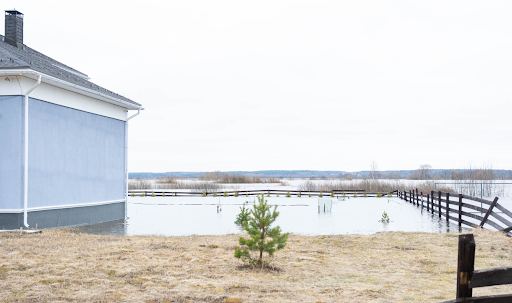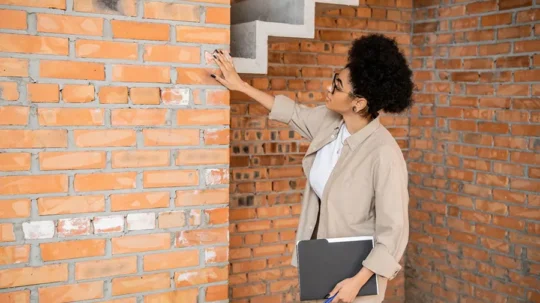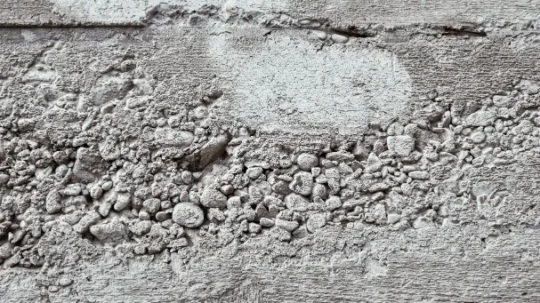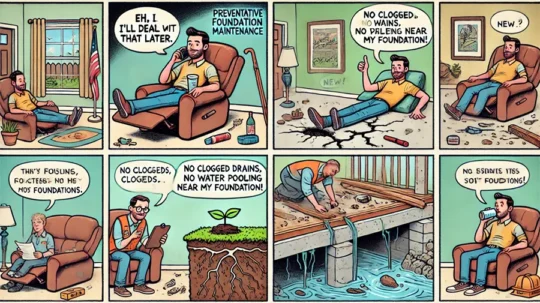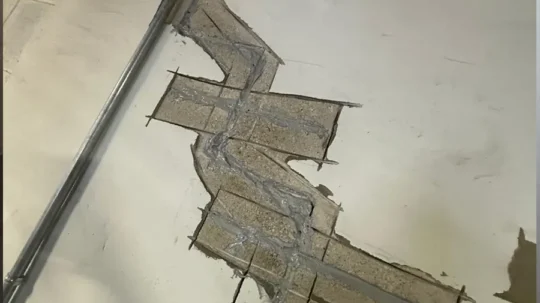
How to Spot a Water Damaged Foundation
Water damage can weaken your foundation, leading to costly repairs. Excess moisture causes cracks, mold growth, and structural instability. Common culprits include poor drainage, hydrostatic pressure, and plumbing leaks. Left untreated, minor leaks can escalate into serious foundation issues. This guide helps homeowners identify the early warning signs of a water damaged foundation, understand the risks, and take proactive steps to protect their property.
Worried About a Water Damaged Foundation in Long Island, Brooklyn, Queens, NY? Get a Free Professional Inspection Now!
What Is Foundation Water Damage?
Water damage is one of the most serious threats to a home’s foundation. But what is foundation water damage, and how does water damage foundation stability over time? When excess moisture seeps into the soil surrounding a foundation, it can cause soil erosion, hydrostatic pressure buildup, and structural weakening. Over time, this leads to cracking, shifting, and even foundation failure if left untreated.
Common Signs of Water Damage to Your House Foundation
Foundation water damage isn’t always obvious, but certain warning signs can indicate serious moisture issues. Catching these early can help homeowners prevent expensive structural damage and enjoy a healthier environment.
Common Signs of Water Damage to Your House Foundation:
- Visible Cracks in Walls or Floors – Small hairline cracks are common, but widening or spreading cracks could indicate serious structural damage.
- Efflorescence (White Powder on Walls) – A chalky residue left by evaporating water, signaling persistent moisture problems.
- Water Stains & Damp Spots – Dark patches on basement walls or floors may suggest water seepage.
- Mold & Musty Odors – Excess humidity leads to mold growth, which can damage indoor air quality and lead to health problems.
- Pooling Water Near the Foundation – Poor drainage or grading can allow water to accumulate around the foundation, increasing pressure on walls.
- Bowing or Leaning Walls – Hydrostatic pressure from excess moisture can cause walls to bulge or shift, a serious structural concern.
Spotting these issues early allows homeowners to take action before major repairs become necessary. Addressing water intrusion with proper waterproofing solutions can help maintain a solid foundation and prevent further damage.
Seeing These Signs? Don’t Wait—Schedule a Waterproofing Assessment Today!
How Water Enters Your Foundation
Water can enter a foundation through cracks, poor drainage, and excessive hydrostatic pressure, leading to serious damage over time. Understanding how moisture infiltrates your home is the first step in preventing basement water damage and maintaining structural integrity.
Common Ways Water Seeps Into Foundations
- Hydrostatic Pressure – When soil around the foundation becomes oversaturated, it exerts pressure on basement walls, forcing water through small cracks and weak spots.
- Poor Drainage & Clogged Gutters – Water pooling around the foundation due to improper drainage or clogged gutters can seep into basement walls and floors.
- Foundation Cracks & Gaps – Even small cracks in concrete can allow water intrusion, worsening over time as moisture expands the gaps.
- Unsealed Basement Windows or Doors – Gaps around windows and doors provide easy entry points for leaks, leading to damp basements and crawl spaces.
- Plumbing Leaks & Indoor Humidity – Hidden leaks from pipes or excessive indoor humidity can increase moisture buildup, leading to mold growth and weakened walls.
Addressing these foundation cracks and drainage issues early can help prevent long-term basement water damage and costly repairs.
Concerned About Water Intrusion? Schedule an Inspection Today!
The Dangers of Ignoring Foundation Water Damage
Ignoring water damage in your foundation can lead to serious structural and health hazards, making timely action crucial. What may seem like minor moisture problems can quickly escalate into severe issues requiring extensive repairs.
Why Foundation Water Damage Should Never Be Ignored:
- Structural Instability – Persistent moisture weakens concrete and can cause foundation walls to crack, bow, or shift.
- Mold Growth & Air Quality Issues – Damp environments promote mold and mildew, which can spread throughout your home and cause respiratory problems.
- Foundation Settlement & Shifting – Water erodes the soil beneath your foundation, leading to uneven floors, misaligned doors, and sinking walls.
- Increased Repair Costs Over Time – Minor leaks and basement water damage can evolve into major structural problems, requiring expensive foundation repairs.
Taking early action can prevent costly foundation repairs and maintain your home’s structural integrity.
Don’t Let Water Damage Worsen—Take Action Now!
Long Island Home Values & Flood Risk: What Homeowners Need to Know
New York is home to around 53 million buildings, all of which are vulnerable to climate change in some way. From 2000 to 2007, home prices on Long Island surged 77.3%, following national housing trends. But between 2007 and 2017, the market took a hit, with the median home value dropping by 23.4%. On average, Long Island homes only appreciated 0.7% per year in real terms over this period.
With sea levels projected to rise 11-16 inches by the 2050s, many Long Island homeowners are already at risk of flooding, foundation damage, and declining property values. Past market trends already show how coastal risk can impact home appreciation—and those who don’t take action may see their property value drop even further.
🔹 The Problem? Homes in flood-prone areas or those impacted by storms like Hurricane Sandy saw even slower appreciation—or lost value altogether. Higher flood insurance premiums, repeated storm damage, and shifting buyer preferences have made these properties less attractive to future buyers.
🔹 The Solution? Waterproofing or flood-proofing your home now can protect your investment, reduce your insurance costs, and keep your property resilient in the face of rising sea levels.
Common Foundation Problems in Long Island
- Flood Zones & Heavy Rainfall – Many areas experience seasonal flooding, increasing moisture exposure.
- High Water Tables – Long Island’s coastal geography means groundwater levels are often close to the surface, causing persistent foundation dampness.
- Expansive & Shifting Soil – The region’s mixed clay and sandy soil expands when wet and contracts when dry, leading to foundation movement.
- Freeze-Thaw Cycles – Water trapped in foundation cracks can freeze in winter, expanding and worsening damage.
These factors make water damage to concrete foundations more common in Long Island, Brooklyn, and Queens, requiring proactive maintenance and repairs.
How to Prevent Water Damage to Your Foundation
Foundation issues caused by water damage can be costly to fix, but prevention is much cheaper than repair. Here’s how you can protect your home and prevent water damage to your foundation:
- Improve Drainage Around Your Home – Extend downspouts, grade your yard away from the foundation, and install French drains.
- Waterproof Your Basement or Crawl Space – Use interior and exterior waterproofing solutions to block moisture.
- Install a Sump Pump – Prevent water buildup by pumping excess moisture away from the foundation.
- Check & Repair Gutters Regularly – Clogged or broken gutters can direct rainwater toward your foundation.
- Seal Foundation Cracks Immediately – Even small cracks can let water in and worsen structural damage over time.
Protect Your Home—Explore Waterproofing Solutions Today!
When to Call a Professional
Some foundation water issues require professional intervention to prevent further damage and costly repairs. While minor moisture problems can often be managed with DIY solutions, certain warning signs indicate a more serious issue that needs expert attention.
Signs You Need a Professional Foundation Inspection:
- Large or Growing Cracks – Cracks wider than 1/8 inch or ones that continue expanding could indicate structural instability.
- Persistent Water Seepage – If water keeps entering your basement despite DIY fixes, it may signal a drainage failure or hidden foundation damage.
- Bowing Walls or Uneven Floors – Hydrostatic pressure from excess moisture can cause foundation walls to bow inward or floors to sink, requiring immediate attention.
- Chronic Mold or Musty Smell – Ongoing dampness and mold growth can lead to air quality issues and long-term health risks.
Ignoring these problems can lead to foundation instability, basement water damage, and costly repairs. Consulting experienced waterproofing contractors ensures that your foundation is assessed properly and protected with the right waterproofing solutions.
Why We’re the Best for Water Damage Foundation Repair in Long Island
If your home has foundation water damage, acting quickly is crucial to prevent further deterioration. At Foundation Concrete Repair, we specialize in water damage foundation repair for homes in Brooklyn, Queens, and Long Island.
- Expert Diagnosis & Honest Pricing – We identify the root cause and provide transparent estimates.
- Specialized Waterproofing Solutions – From sump pumps to French drains, we stop moisture at the source.
- Structural Repairs That Last – Whether it’s crack injections or foundation underpinning, we fix it right the first time.
- Flexible Financing Available – Don’t let cost stop you from protecting your home—we offer financing options to fit your budget.
How to Spot a Water-Damaged Foundation: Final Thoughts
Having a water-damaged foundation is a serious issue, but early detection and proper waterproofing can protect your home. Small warning signs—such as damp spots, minor cracks, or musty odors—can quickly escalate into major structural issues if left unchecked.
Taking proactive steps, like improving drainage, sealing foundation cracks, and investing in basement waterproofing, helps prevent costly repairs. When moisture problems persist, hiring a foundation inspection expert can provide the best long-term solution.
Homeowners should act quickly to avoid extensive foundation damage and ensure their homes remain safe, dry, and structurally sound for years to come.
Water Damage Threatening Your Long Island Property? Keep Your Foundation Strong—Schedule a Free Assessment Now!




